15.6: Structures of the Female Reproductive System
- Last updated
- Save as PDF
- Page ID
- 103278
Fertility Symbol
The geometric design on this ancient stone carving represents a powerful symbol of fertility: the vagina. The symbol is called yoni in Hindu, and it reflects the value placed by Hindu culture on the ability to give birth. The vagina is one of several organs in the female reproductive system.

Female Reproductive Organs
The female reproductive system is made up of internal and external organs that function to produce haploid gametes called eggs (or oocytes), secrete sex hormones (such as estrogen), and carry and give birth to a fetus. As shown in Figure \(\PageIndex{2}\), the internal reproductive organs include the vagina, uterus, Fallopian (uterine) tubes, and ovaries. The external organs — collectively called the vulva — include the clitoris and labia.
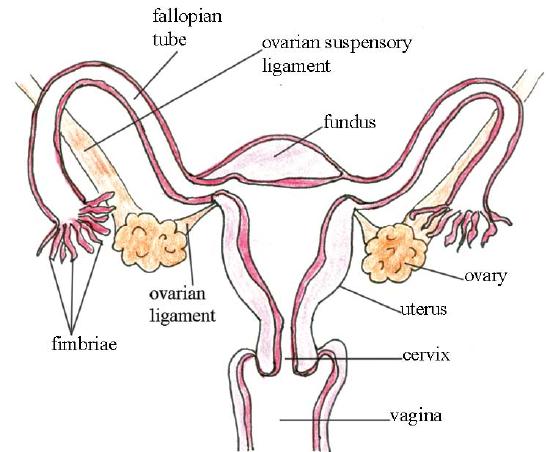
The vagina is an elastic, muscular canal leading from its opening in the vulva to the neck of the uterus, called the cervix. It is about 7.5 cm (3.0 in.) long at the front, and about 9 cm (3.5 in.) long at the back. The vagina accommodates the penis and is the site where sperm are usually ejaculated during sexual intercourse. In the context of pregnancy and natural (vaginal) childbirth, the vagina is also referred to as the birth canal. In addition, it channels the flow of menstrual blood from the uterus.
Structure of the Vagina
The vagina, shown at the bottom of Figure \(\PageIndex{2}\), is a muscular canal (approximately 10 cm long) that serves as the entrance to the reproductive tract. It also serves as the exit from the uterus during menses and childbirth. The outer walls of the anterior and posterior vagina are formed into longitudinal columns or ridges, and the superior portion of the vagina—called the fornix—meets the protruding uterine cervix. The walls of the vagina are lined with an outer, fibrous adventitia; a middle layer of smooth muscle; and an inner mucous membrane with transverse folds called rugae. Together, the middle and inner layers allow the expansion of the vagina to accommodate intercourse and childbirth. The thin, perforated hymen can partially surround the opening to the vaginal orifice. The hymen can be ruptured with strenuous physical exercise, penile-vaginal intercourse, and childbirth. The Bartholin’s glands and the lesser vestibular glands (located near the clitoris) secrete mucus, which keeps the vestibular area moist.
The vagina is home to a normal population of microorganisms that help to protect against infection by pathogenic bacteria, yeast, or other organisms that can enter the vagina. In a healthy individual, the most predominant type of vaginal bacteria is from the genus Lactobacillus. This family of beneficial bacterial flora secretes lactic acid, and thus protects the vagina by maintaining an acidic pH (below 4.5). Potential pathogens are less likely to survive in these acidic conditions. Lactic acid, in combination with other vaginal secretions, makes the vagina a self-cleaning organ. However, douching—or washing out the vagina with fluid—can disrupt the normal balance of healthy microorganisms, and actually increase the risk for infections and irritation. Indeed, the American College of Obstetricians and Gynecologists recommend that people do not douche and that they allow the vagina to maintain its normal healthy population of protective microbial flora.
Uterus
The uterus (commonly called the womb) is a pear-shaped, muscular organ that is about 7.6 cm (3 in.) long. It is located above the vagina and behind the bladder in the center of the pelvis. The position of the uterus in the pelvis is stabilized by several ligaments and bands of supportive tissue. The uterus is where a fetus develops during gestation, and the organ provides mechanical protection and support for the developing offspring. Contractions of the muscular wall of the uterus are responsible for pushing the fetus out of the uterus during childbirth.
Parts of the Uterus
As shown in Figure \(\PageIndex{3}\), the lower end of the uterus forms the cervix, which is also called the neck of the uterus. The cervix is about 2.5 cm (1 in.) long and protrudes downward into the vagina. A small canal runs the length of the cervix, connecting the uterine cavity with the lumen of the vagina. This allows semen deposited in the vagina to enter the uterus, and a baby to pass from the uterus into the vagina during birth. Glands in the cervix secrete mucus that varies in water content and thickness, so it can function either as a barrier to keep microorganisms out of the uterus during pregnancy or as a transport medium to help sperm enter the uterus around the time of ovulation. The rest of the uterus above the cervix is called the body of the uterus. The upper end of the uterus is connected with the two Fallopian tubes.
Tissues of the Uterus
As indicated in Figure \(\PageIndex{3}\), the uterus consists of three tissue layers, called the endometrium, myometrium, and perimetrium.
- The endometrium is the innermost tissue layer of the uterus. It consists of epithelial tissue, including mucous membranes. This layer thickens during each menstrual cycle and, unless an egg is fertilized, sloughs off during the following menstrual period. If an egg is fertilized, the thickened endometrium is maintained by hormones and provides nourishment to the embryo. As gestation progresses, the endometrium develops into the maternal portion of the placenta. The placenta is a temporary organ that consists of a mass of maternal and fetal blood vessels through which the mother’s and fetus’s blood exchange substances.
- The myometrium is the middle layer of the uterus. It consists mostly of a thick layer of smooth muscle tissue. Powerful contractions of the smooth muscle allow the uterus to contract and expel an infant during childbirth.
- The perimetrium is the outermost layer of the uterus. It covers the outer surface of the uterus. This layer actually consists of two layers of epithelium that secrete fluid into the space between them. The fluid allows for small movements of the uterus within the pelvis, without causing it to rub against other organs.
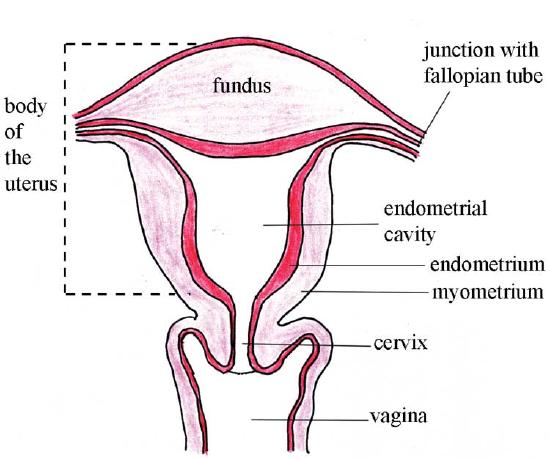
Fallopian Tubes
The Fallopian tubes (Figure \(\PageIndex{2}\)) are two thin tubes that lie between the ovaries and the uterus. The Fallopian tubes are not attached to the ovaries, but their broad upper ends — called infundibula — lie very close to the ovaries. The infundibula also have fringe-like extensions called fimbriae that move in a waving motion to help guide eggs from the ovaries into the Fallopian tubes. The lower ends of the Fallopian tubes are attached to the upper part of the body of the uterus on either side of the body. They open into the uterus. Egg is fertilized in the fallopian tubes.
Ovaries
The ovaries are the gonads. Paired ovals, they are each about 2 to 3 cm in length, about the size of an almond. The ovaries are located within the pelvic cavity and are supported by many ligaments. The ovaries are the ovum-producing organs of the internal reproductive system. The ovary is an ovum-producing reproductive organ, typically found in pairs. Ovaries are analogous to testes in that both are gonads and endocrine glands. Ovaries secrete both estrogen and progesterone. Estrogen is responsible for the appearance of secondary sex characteristics of females at puberty and for the maturation and maintenance of the reproductive organs in their mature functional state. Progesterone functions with estrogen by promoting menstrual cycle changes in the endometrium.
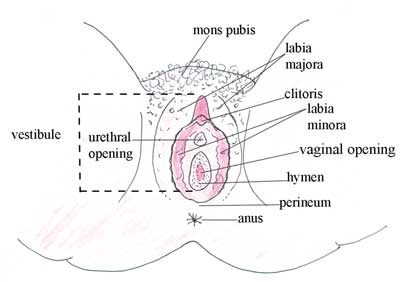
Vulva
The external reproductive structures are referred to collectively as the vulva (Figure \(\PageIndex{4}\)). The mons pubis is a pad of fat that is located at the anterior, over the pubic bone. After puberty, it becomes covered in pubic hair. The labia majora (labia = “lips”; majora = “larger”) are folds of hair-covered skin that begin just posterior to the mons pubis. The thinner and more pigmented labia minora (labia = “lips”; minora = “smaller”) extend medially to the labia majora. Although they naturally vary in shape and size, the labia minora serve to protect the urethra and the entrance to the reproductive tract.
The superior, anterior portions of the labia minora come together to encircle the clitoris (or glans clitoris), an organ that originates from the same cells as the glans penis and has abundant nerves that make it important in sexual sensation and orgasm. The hymen is a thin membrane that sometimes partially covers the entrance to the vagina. An intact hymen cannot be used as an indication of “virginity”; even at birth, this is only a partial membrane, as menstrual fluid and other secretions must be able to exit the body, regardless of penile-vaginal intercourse. The vaginal opening is located between the opening of the urethra and the anus. It is flanked by outlets to the Bartholin’s glands (or greater vestibular glands).
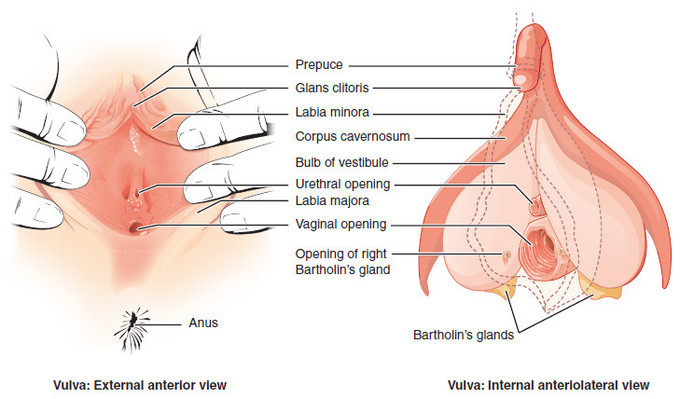
Breasts
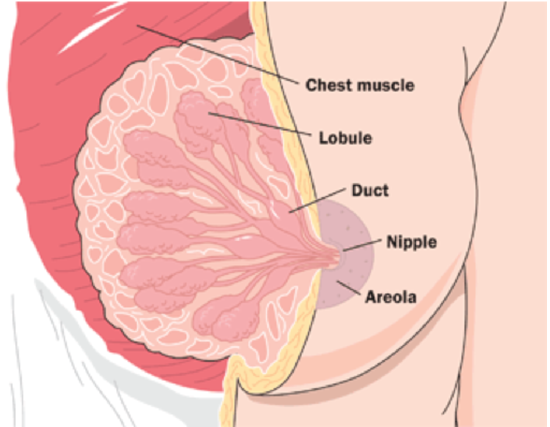
The breasts are not directly involved in reproduction, but because they contain mammary glands, they can provide nourishment to an infant after birth. The breasts overlay major muscles in the chest from which they project outward in a conical shape. The two main types of tissues in the breast are adipose (fat) tissue and glandular tissue that produces milk. As shown in Figure \(\PageIndex{6}\), each mature breast contains many lobules, where milk is produced and stored during pregnancy.
During nursing (or lactation), the milk drains into ducts and sacs, which in turn converge at the nipple. Milk exits the breast through the nipple in response to the suckling action of an infant. The nipple is surrounded by a more darkly pigmented area called the areola. The areola contains glands that secrete an oily fluid, which lubricates and protects the nipple during breastfeeding.
In 2018, during a survey, the respondents mentioned about two protocols of lactation induction in a trans woman, Zil Goldstein and Newman-Goldfarb protocols, which was initially designed for a cis woman to nurse a baby born to a surrogate mother. The Zil Goldstein protocol starts with 10 mg domperidone (a drug) three times daily while the Newman-Goldfarb protocol recommends 10 mg domperidone four times daily. Both regimens subsequently increase the dose to 20 mg four times daily. Since domperidone is not approved by the Food and Drug Administration, the patients obtain the drug elsewhere. Both regimens also utilize estradiol and progesterone sex hormones. Subsequently, the physical stimulation of the nipples is recommended for milk production. Informal reports of trans women who induced lactation have emerged recently. However, there are no data to support any of the other reports. There is a critical gap in evidence-based medicine for this population.
Review
- State the general functions of the female reproductive system.
- Describe the vagina and its reproductive functions.
- Outline the structure and basic functions of the uterus.
- What is the endometrium? How does it change during the monthly cycle?
- Relate features of the Fallopian tubes to the functions of these structures.
- Define ovary.
- Identify the functional units of the ovaries.
- Discuss the timing of egg production and ovulation in the context of a female’s lifetime.
- What is the vulva? What structures does it include?
- Why are breasts included in discussions of reproduction, if they are not organs of the female reproductive system?
- What is the function of the folds in the mucous membrane lining of the vagina?
- What are two ways in which the female reproductive system protects itself from pathogens?
- True or False: The fallopian tube runs through the cervix and allows sperm to enter the uterus.
- True or False: The nipple and the areola are not the same things.
- Immature eggs are located in __________, which are located within _________ .
Explore More
Attributions
- Cattien stone yoni by Binh Giang, public domain via Wikimedia Commons
- Female reproductive organs by The Open University, licensed CC BY-NC-SA 4.0
- Uterus regions by The Open University, licensed CC BY-NC-SA 4.0
- Vulva by The Open University, licensed CC BY-NC-SA 4.0
- Vulva by OpenStax, licensed CC BY 3.0
- Breast diagram by NCI NIH, public domain via Wikimedia Commons
- Text adapted from Human Biology by CK-12 licensed CC BY-NC 3.0
- Some text is adapted from Trautner, Emily et al. “Knowledge and practice of induction of lactation in trans women among professionals working in trans health.” International breastfeeding journal vol. 15,1 63. 16 Jul. 2020, doi:10.1186/s13006-020-00308-6; CC BY 4.0


